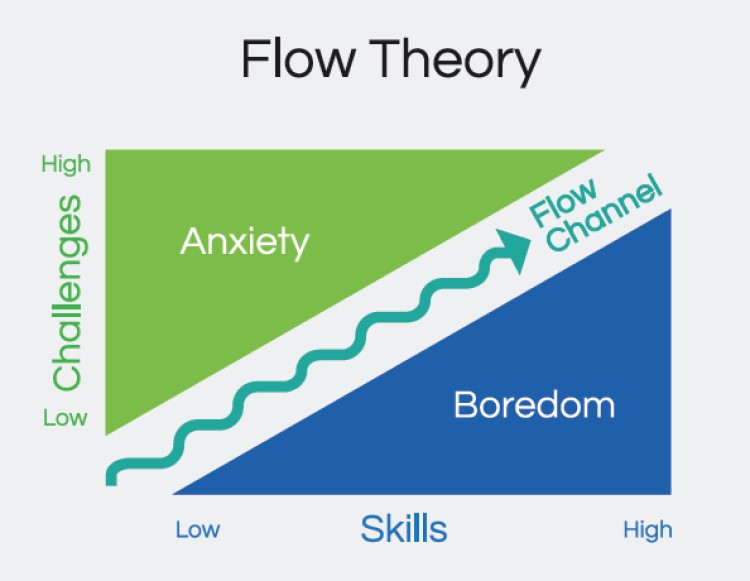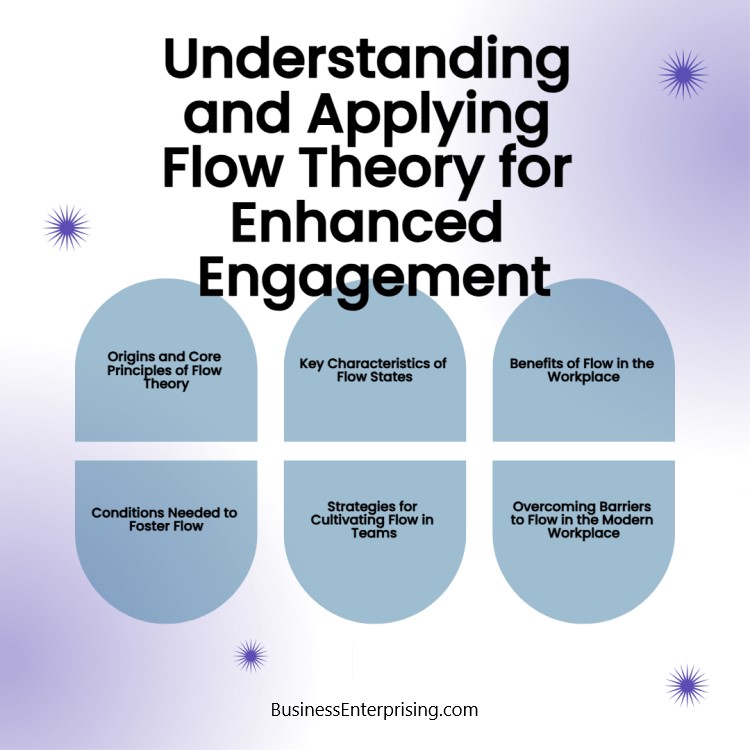
Introduction to Flow Theory: Origins and Core Principles
Flow Theory, introduced by psychologist Mihaly Csikszentmihalyi, explores the experience of complete immersion in a task. When in a “flow” state, you feel deeply engaged, as if time and self-consciousness fade away. Flow Theory emphasizes that achieving these peak states of focus enhances both productivity and personal satisfaction.
Csikszentmihalyi developed Flow Theory to understand the conditions that help people reach this high level of engagement. He observed that flow occurs when there’s a balance between the difficulty of a task and your skill level. If a task is too easy, you may become bored. If it’s too challenging, you can feel anxious. But when skill and challenge align, you’re more likely to reach flow.
In the workplace, Flow Theory shows how you can structure tasks to improve focus and motivation. By providing clear goals, immediate feedback, and opportunities to use your skills, you’re more likely to experience flow. This state not only boosts your productivity but also creates a sense of fulfillment, making work more enjoyable and meaningful.
Key Characteristics of Flow States
In Flow Theory, flow states are defined by several key characteristics that create a deeply immersive experience. One defining trait is intense focus. When you’re in a flow state, your attention narrows entirely to the task at hand. External distractions fade, allowing you to give your full energy to the work. This heightened concentration contributes significantly to productivity and creativity.
Another characteristic is the loss of self-consciousness. In flow, you become so absorbed in what you’re doing that self-doubt or awareness of others disappears. This freedom from self-consciousness can lead to more authentic and uninhibited actions, helping you to perform without hesitation or second-guessing.
Time distortion also plays a crucial role in the flow experience. When in flow, you may lose track of time, either feeling as if it speeds up or slows down. Hours can pass in what feels like minutes, or a few moments might feel stretched. This time distortion reflects the depth of your engagement, as your focus on the task is so complete that you’re not measuring time. Flow Theory highlights these traits as essential components of peak engagement, which can greatly enhance your productivity and satisfaction.
Benefits of Flow in the Workplace
Flow Theory shows that achieving flow in the workplace can offer significant benefits for productivity and well-being. When you reach a flow state, you’re fully immersed and focused, which allows you to work efficiently. This intense concentration leads to completing tasks faster and often with higher quality, as distractions are minimized. Consequently, productivity rises when you and your team experience flow regularly.
Moreover, flow can greatly enhance job satisfaction. When in flow, work feels rewarding rather than burdensome. You feel challenged but capable, which fosters a sense of accomplishment and fulfillment. According to Flow Theory, this experience of engagement can make daily tasks feel less routine and more enjoyable, which boosts your overall satisfaction with your job.
Flow also contributes to employee well-being by reducing stress. When you experience flow, you’re absorbed in meaningful tasks, which can create a sense of purpose and reduce feelings of anxiety. This can positively impact mental health, as work becomes a source of enjoyment rather than tension. Flow Theory illustrates that by creating conditions for flow, workplaces can foster environments where productivity, satisfaction, and well-being thrive.
Conditions Needed to Foster Flow
Flow Theory suggests that achieving flow requires specific conditions. One key factor is having clear goals. When you understand exactly what needs to be accomplished, your focus sharpens, which reduces distraction. Clear objectives allow you to channel energy toward meaningful progress, making it easier to lose yourself in the task.
Another crucial element is balancing skill and challenge. Flow Theory emphasizes that you’re more likely to enter flow when tasks are challenging enough to engage your skills but not so difficult that they cause frustration. This balance keeps you motivated and fully absorbed, as the activity feels both rewarding and achievable. If the challenge level matches your skill, you stay engaged, without boredom or anxiety disrupting your focus.
Immediate feedback is also essential for fostering flow. Feedback allows you to adjust quickly, keeping you aligned with your goals. Knowing how well you’re doing reinforces your focus and drives improvement. Flow Theory shows that timely feedback helps you stay engaged, as you can correct mistakes or refine your approach without delay.
Strategies for Cultivating Flow in Teams
To foster flow within teams, managers can leverage strategies that align with Flow Theory principles. Task design is essential. Break tasks into manageable sections that match the team’s skill level, creating a balance that keeps members engaged without overwhelming them. This structure allows team members to concentrate fully, making it easier to enter a flow state.
Goal setting also plays a crucial role in cultivating flow. Setting clear, meaningful goals that align with each team member’s strengths gives them a sense of direction and purpose. When individuals know exactly what they need to achieve, they can focus their energy more effectively. Goals should be specific and measurable, helping team members track their progress and adjust as needed, which reinforces engagement and motivation.
Removing distractions is equally important in supporting flow states. Encourage your team to set aside dedicated time for focus by minimizing interruptions like emails, unnecessary meetings, or loud environments. Flow Theory highlights that an environment free from distractions enables deeper concentration, so consider scheduling blocks of uninterrupted work time. When team members can immerse themselves fully, their productivity and job satisfaction tend to increase, creating a more engaged and effective team.
Overcoming Barriers to Flow in the Modern Workplace
In the modern workplace, achieving flow can be challenging due to constant interruptions and the demands of multitasking. These barriers disrupt concentration, making it difficult for you to reach the deep engagement Flow Theory encourages. Frequent notifications, meetings, and other interruptions can break focus, preventing you from fully immersing in tasks. To address this, consider scheduling specific blocks of time dedicated to focused work, minimizing external interruptions.
Multitasking is another significant barrier to flow. Shifting attention between tasks dilutes focus, reducing efficiency and increasing stress. Flow Theory suggests focusing on one task at a time to enter a productive state. Encourage prioritizing tasks and completing them sequentially, which can help you sustain engagement and reduce mental fatigue. By dedicating time to one project without distraction, you can enhance productivity and increase job satisfaction.
Finally, creating an environment that supports focus is essential. You can foster flow by managing noise levels and providing spaces that encourage concentration. Allowing employees to customize their workspaces to suit their focus preferences can also support flow states.
Conclusion
Flow Theory provides a valuable framework for enhancing productivity and job satisfaction. By fostering conditions that allow you to enter a flow state, you can experience deeper engagement in your work. Achieving flow requires balancing challenges with skills, setting clear goals, and creating an environment that minimizes distractions. When you feel fully immersed and focused, your work becomes more fulfilling and efficient. Embracing Flow Theory can benefit both individual well-being and overall organizational performance. As you apply these principles, you can help cultivate a workplace that supports focus, creativity, and lasting engagement.


